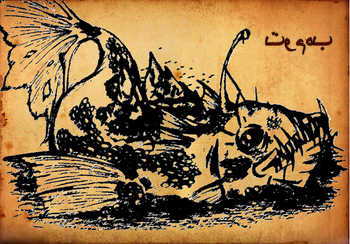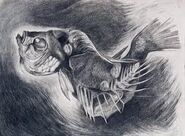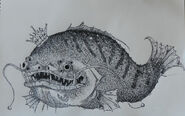
Traditional depiction of Bahamut
Bahamut or Bahamoot (Arabic: بهموت) is a vast fish and Jinn that supports a landmass in Islamic lore. In some sources, Bahamut is described as having a monstrous head with large teeth, similar to that of a hippopotamus.
Overview
In Arabic myth, the Bahamut is a giant fish that supports land. In Jorge Luis Borges' Book of Imaginary Beings, Bahamut is "altered and magnified" from Behemoth, and described as so immense that a human cannot bear its sight; "Edward William Lane cites two cosmological accounts from Ibn al-Wardi (d. 1348 CE) that feature Bahamut. One account describes Bahamut as a fish floating in water, supported by darkness. On the fish is a bull called Kujata, on the bull, a ruby mountain; on the mountain, an angel; the angel holds and supports the seven earths. In another account, Bahamut supports a bed of sand, on which stands a bull, on whose back rests a rock which holds the waters in which the earth is located. Beneath the fish are layers of suffocating wind, a veil of darkness, and mist. Other sources describe Behemoth as a layer in similar conceptions of Arabic cosmography.

Artist’s rendering
According to Borges, Bahamut is the giant fish that Isa beholds in the 496th night of the One Thousand and One Nights. Bahamut in this telling is a giant fish swimming in a vast ocean. It carries a bull on its head; the bull bears a rock, and above the rock is an angel who carries the seven stages of the earths. Beneath Bahamut is an abyss of air, then fire, and beneath that a giant serpent called Falak.
Upon seeing Bahamut, Isa passes into unconsciousness: At this sight Isa fell down aswoon, and when he came to himself, Allah spake to him by inspiration, saying, 'O Isa, hast thou seen the fish and comprehended its length and its breadth?' He replied, 'By Thy honour and glory, O Lord, I saw no fish; but there passed me by a great bull, whose length was three days' journey, and I know not what manner of thing this bull is.' Quoth Allah, 'O Isa, this that thou sawest and which was three days in passing by thee, was but the head of the fish; and know that every day I create forty fishes like unto this.'
Borges cites the idea of Bahamut as part of a layered cosmology as an illustration of the cosmological existence of God, which infers a first cause from the impossibility of infinite prior causes. He also draws parallels between Bahamut and the mythical Japanese fish Jinshin-Uwo.


